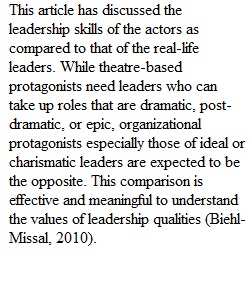


Q The preparation of Annotated Bibliographies is an important part of doctoral studies. It allows you, as a student, to discover research related to your field of study and to capture important elements of this research. At the doctoral level, assertions need to either be proven or properly referenced. As a result, you need to use academically refereed or peer-reviewed journals to search for related research. You should look for research that both supports and contradicts your research efforts. In reviewing this additional research, you need to go beyond simply reading the articles to complete critical analyses of the purpose, research methods, and results documented in the article. Each annotated bibliography includes the following three components. As this is your one opportunity to provide objective analysis, you need to use the 500 words. It is required that citations be included in the annotated bibliography as what you are writing comes directly from the article. Each paragraph should be cited. Failure to do so will result in a significant deduction of points. You may not use direct quotes in this assignment as everything should be paraphrased with the appropriate citations. • Critical Summary of Article (150-200 words) o Summarize the major themes of the journal article. o Define the research problem being addressed by the author(s). o Describe and discuss the relationships among the research problem, research questions, and hypotheses. • Critical Analysis of Research Methodology (150-200 words) o Comment on whether the author(s) used appropriate research methods to complete the research – be specific. o Describe the specific research methods used – go beyond just stating whether a qualitative or quantitative model was used. o Describe whether the author(s) used a sample and how the sample was determined – as appropriate. State whether the sample design was appropriate for the study. o Describe the variables or functions measured and whether these variables or functions were appropriate for the study. o Discuss whether the data collection process and analyses were done properly. Reference related statistics, if used in the study. o Summarize whether the research methods support the conclusions reached by the author(s). o You cannot indicate that there is no research method in this assignment. You cannot say there is not disciplined research methodology. If an article does not have an identifiable methodology, please find another article. • Critical Analysis of the Results and Conclusions (100- 150 words) o Summarize the results and conclusions of the article. o Discuss how these results either support or do not support your research. APA Requirements Please follow these requirements: • Use correct APA citation in referencing the journal article. • Use APA formatting guidelines (e.g. headings, line spacing in the annotation). • Use correct grammar, punctuation, and spelling. Annotation Tips The following tips are provided to help complete the annotation • Start each annotation at the top of a new page. • Start with the correct APA reference for the article. This comes before your analysis begins. You must cite within the assignment. • Include all three level one headings: (1) Critical Summary of Article, (2) Critical Analysis of Research Method, (3) Critical Analysis of the Results and Conclusions. • Write clearly and focus on the critical parts of the research. • Use these general guidelines on keeping the annotation to 500 word.
View Related Questions